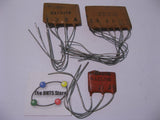|
One of the more unusual requests I get from restorers and vintage gear enthusiasts is for assistance in either identifying or sourcing PECs (printed electronic circuits). These are small non-descript rectangular shaped modules with 3 or more wire leads or pins. They usually have a ceramic finish and a single part number with a manufacturers logo (usually). Their purpose was to house several components such as resistors, capacitors and sometimes inductors or diodes in a single package, thus reducing component count and finished product cost. They were the pre-cursor - at least in design philosophy - to the hybrid circuit which became popular in the 1980s before low cost, small production run ASICs became a possibility. Locating replacements for these parts is difficult at best. The manufacturers that made them often designed them as custom products for a specific application or consumer product line. Even in their heyday there was a lack of design and replacement information for these parts, and the conspiracy theorist in me speculates this was not by accident as is served to protect the design and restrict unauthorized repairs. These devices were used from the 1940s well into the 1970s in tube equipment. The design philosophy was later ported over to solid state consumer products. So why did I write this? The idea was born out of the observed lack of PEC device information available, and my fear that less information may be available in the future. I want to evolve this page in an attempt to gather and publish information on these devices that it might help vintage equipment restoration and repair enthusiasts. Manufacturers' nomenclature:
Strategies for replacement:
|
Links to Information: Antique Radio Forums (Search for word Couplate) PECs on eBay
Other Links: Dave's Junkyard Blog |


CommentsCommentaires
PostedPublié February 17 2020 at 09:21PM bypar Roberta X
Thank you! I just purchased a little transmitter with a couple of “Couplates” in the modulator, so this information will be useful.